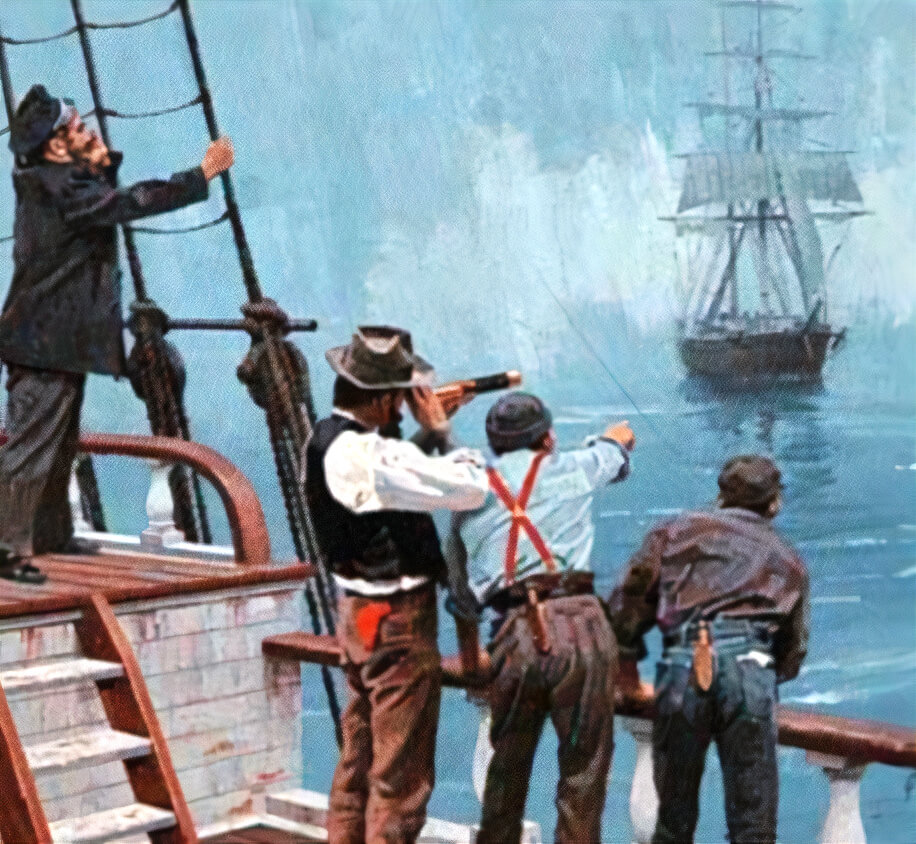
(painting by Gordon Johnson)
Project Mary Celeste
A REMOTE VIEWING ESSAY BY SITA SEERY
October 12, 2003
Introduction
One of the fascinating maritime mysteries of the world was the fate of the captain and crew of the vessel Mary Celeste. In June 2003, six members of the Hawaii Remote Viewers’ Guild embarked on a reconnaissance into the collective matrix to retrieve information on the captain and crew’s disappearance.
The target was cued as “VESSEL MARY CELESTE/DISAPPEARANCE EVENT/NEW YORK TO GENOA, ITALY/1872”. It was encrypted with an alphanumeric target identification given to special sessions that normally come under the category “operational targets.” The alpha-numeric designation for this target was E1N3-M3B1.
As targeteer for this event, I intended for the viewer to initially recognize the vessel, but move ahead from the vessel to the actual disappearance event.
Background Of The Mary Celeste
The Mary Celeste was built in 1860, an investment of a group of ambitious shipbuilders at the shipyards of Joshua Dewis on Spencer’s Island, Nova Scotia. Originally christened as the Amazon and launched in 1861, the vessel went through a series of skippers and mishaps prior to the disappearance of its crew in 1872. The first skipper was a Scotsman by the name of Robert McClellan who became ill and died shortly after taking over command. John Nutting Parker assumed command and skippered the Amazon’s maiden voyage; however she ran into a fishing weir off the coast of Maine, which gashed her hull and caused her to go into dry-dock for repair. While in dry-dock, a fire broke out amidships, which consequently ended Parker’s command. The Amazon’s first Atlantic crossing went without event until she entered the Straits of Dover and collided with a brig. The brig sank and the Amazon once again, went into dry dock for more repairs while her third skipper searched for another command. After repairs were completed, The Amazon returned to America, where once again, she ran aground off Cow Bay, Cape Breton Island in Nova Scotia.
She eventually changed hands and owners several times. It appeared that several previous owners seemed to have gone bankrupt after acquiring the vessel. She finally passed into the hands of J.H. Winchester and Co., a conglomerate of New York ship owners. She had undergone so many structural changes by this time that her appearance did not resemble the original vessel as it was built. By the time J.H. Winchester and Company acquired the ship, she had been enlarged and flew the American flag. Her name was changed to the Mary Celeste. One report stated that “it has been suggested that the peculiar mixture of English and French names was the result of the painter’s error, the intended name being Mary Sellers or even perhaps Marie Celeste.”1
The Ill Fated Final Voyage Of The Members And Crew Of The Mary Celeste

Numerous articles and books have been written about the disappearance of the Mary Celeste’s crews. The following is a compendium of data gleaned from several reports and articles on the Mary Celeste.
In early October 1872, the Mary Celeste was berthed at Pier 44 in the East River of New York, ready to take on some new cargo and crew. The new skipper was a taciturn puritan New Englander named Benjamin Spooner Briggs.
Research into the character of this man established him as a well grounded, devoutly religious, and moral man, a capable and experienced seafarer, and a shareholder of the Mary Celeste.
The first mate was Albert G. Richardson. He was a Civil War veteran and had previously served with Captain Briggs. Records indicate that he, also, was trustworthy and a very competent individual.


Captain Briggs brought his wife, Sarah, and two year old daughter, Sophia Matilda on the journey. Captain Briggs had his cabin aboard the Mary Celeste remodeled in order to accommodate his family. The brig was loaded with 1701 barrels of grain alcohol to be transported to Genoa, Italy. The passengers and crew totaled about 10 people: 7 crewmen of German descent, Captain Briggs, and his family.
On November 7, 1872, the Mary Celeste began its voyage from New York’s East River with its crew and cargo of American alcohol, valued at approximately $35,000. The alcohol was to be used by the Italians to fortify wine.

On November 15, 1872, the Dei Gratia was launched on a parallel course carrying a cargo of 1,735 barrels of petroleum.
On the afternoon of December 5, 1872, midway between the Azores and the coast of Portugal, the Dei Gratia came upon the Mary Celeste. They noted that the ship was sailing erratically. Captain Morehouse and his crew watched the Mary Celeste for approximately two hours.

Several attempts at hailing her went unrecognized by the Mary Celeste. According to an excellent report2 written by Captain David Williams (www.deafwgake,cin/maryceleste), the Dei Gratia crew was unable to spot anyone on board the Mary Celeste. The Dei Gratia dispatched a boarding party lead by 1st Mate Oliver Deveau.
Mr. Deveau’s investigative party returned and reported that the ship was fully provisioned and seaworthy. It appeared as though the crew of the Mary Celeste had launched a small yawl and abandoned ship for unknown reasons.
The cargo was in good condition, with the exception of one damaged barrel. Most of the crew’s personal items were somewhat soaked, but still on board. The majority of the ship’s papers and navigational equipment was missing; however, the log remained, with the last entry being a November 25 sighting of St. Mary’s Island, approximately 700 miles from where the vessel was found.
When the ship was discovered by the Dei Gratia, there were six months supply of food and potable water on board. One pump was out of order and two sails were gone, but Chief Mate Deveau was confident that he could get the ship to Gibraltar with a small crew. The Dei Gratia’s skipper, Captain Morehouse was concerned that the Dei Gratia’s crew would be grossly undermanned, a situation, one would not want to be in during emergency situations. However, Mr. Deveau’s argument prevailed and the vessel was taken to Gibraltar.
What happened to the crew? What caused them to hastily abandon ship, leaving their provisions and personal belongings behind?
The Remote Viewing Experience Of The Crew And Ship Members’ Fate
Readers familiar with the HRVG methodology of remote viewing know that in analysis, substantiation of an event must be corroborated by two or more viewers. I was the targeteer for this project. None of the viewers who worked this target had any previous knowledge or hints about the data. Most of our sessions are worked under blind conditions or double blind conditions. This means that the target is cued by a trained “targeteer.” The targeteer associates a randomly selected set of letters and numbers with the target that the viewer is expected to work known as the target identification. The target identification and feedback image, if any, is sealed in an opaque envelope. The viewer is given only the encrypted target identification. The viewers work the target by following a systematic program of procedures known in the remote viewing community as “protocols.” In HRVG, the protocols are designed to occupy the remote viewer’s primary awareness, while training the subconscious to provide target related data. The viewer “perceives” the data presented by his/her subconscious and renders a graphic and narrative illustrative of the perceptual article, event, person, or place.
The quality of the viewers’ work is predicated on many factors. The vicissitudes of remote viewing are the constant hammering of data streaming from the viewers’ imagination, external stimuli, or other types of interference. Viewers have repeatedly demonstrated that the slightest distraction can send the sub into many unrelated realms and plateaus that tend to pollinate correct data, thus throwing the unwary viewer off target. In all target work, it is not uncommon for viewers to illustrate both relevant and irrelevant data. The weeding of good data from the chaff of unrelated information is a skill that requires months of practice, coupled with the discipline to discern correct data streaming into the primary awareness from the subconscious. The following work produced by members and associates of the Guild is a strong indication of this discipline (or lack).
I believe that the most effective analytical assessment is one where the analyst is familiar with the remote viewer’s idiosyncratic tendencies. This knowledge is valuable in assessing the viewers’ work when objects, people, places, or events, are metaphorically represented.
Rene Warcollier, whom some consider as the father of Remote Viewing, wrote in his book on telepathy3: “When we ask a person to look into his mind and to describe how thought presents itself, he usually answers that he senses it in the form of images, more or less clear, like unfinished drawings. For instance, if it is an idea of a horse, he will see its silhouette, hear the word horse, or see this word. Others…will have the idea of the movement of the legs of a horse or will see a particular horse.
Still others will hear hoof-beats. Among persons with a mental bent toward abstraction or generalization, who think without clear imagery, the idea of a horse does not seem to lead to a clear representation. There is only the sensation of a vague, incomprehensible, mental presence…” The data transcribed from our Guild viewers will substantiate Mr. Warcollier’s observations almost to the letter.
The difficulty I sometimes encounter as a targeteer and analyst working with operational targets is that collecting data on events, especially missing person-type targets is sometimes a multi step process. In this project, the viewer had to first identify the vessel and then move from the vessel to the disappearance of its crew. My experience with these types of targets has been such that sometimes the viewer, myself included, does not make the transition from the vessel (the intended imagery projected from the subconscious) to the intended target.
Sometimes the viewer will obtain some data relative to the base target, in this case, the Mary Celeste, but may be caught up in the mechanics of the ship itself and never leap to the actual intended target, the cause of the crew’s disappearance. I believe that this may be why we sometimes have problems obtaining the data required that would significantly contribute to the resolution of an operational target’s query. However, I must caveat that by adding that a highly disciplined and skilled remote viewer can, and have, in past target work, moved from the immediate to the tertiary target.
The discipline involved requires the viewer to first psychologically associate the target identification with the basic gestalts congruent with the intended target. For example, the viewers’ work in the data collection matrix known as S1 Playfair was correctly perceived in identifying that the target was related to humans or that humans were interfaced in this target.


Additionally, Dick had a sense of something dripping and “ploinking” down.



The viewer also correctly perceived that a vehicle or vessel was involved. In the graphic to the right, Allen’s sub communicated that the target had something to do with a boat or watercraft.
Sometimes our sub will relay to us in images and forms with which we are most familiar. In Allen’s case, a submarine metaphorically represented a boat to him.

Here is another sketch of Allen’s. Interestingly, the wavy line above the craft indicates the surface gestalt of his landscape. He translated the image into a submersible watercraft. This sketch indicates some contamination on the viewer’s part; however, basic gestalt is correct. Of all the objects he could have sketched, he drew a craft that operates in water. The sense of stale air and poor circulation inside the craft may also be correct when one breaks the elements into the basic gestalt. The Mary Celeste’s compartments below deck may have been such that would invigorate the viewer’s mind to sense stale air and poor circulation. Allen associated it with his submarine graphic. The fundamental similarity between his ship and the Mary Celeste was that something was floating and within the structure, hot, stale air and poor circulation was evident.
Some aspects of a target will have more significance to some viewers than others. In Debbie’s work in Playfair, the grain alcohol may have caught her attention, while other viewers were cognizant of the sweat and body odors of the crew.

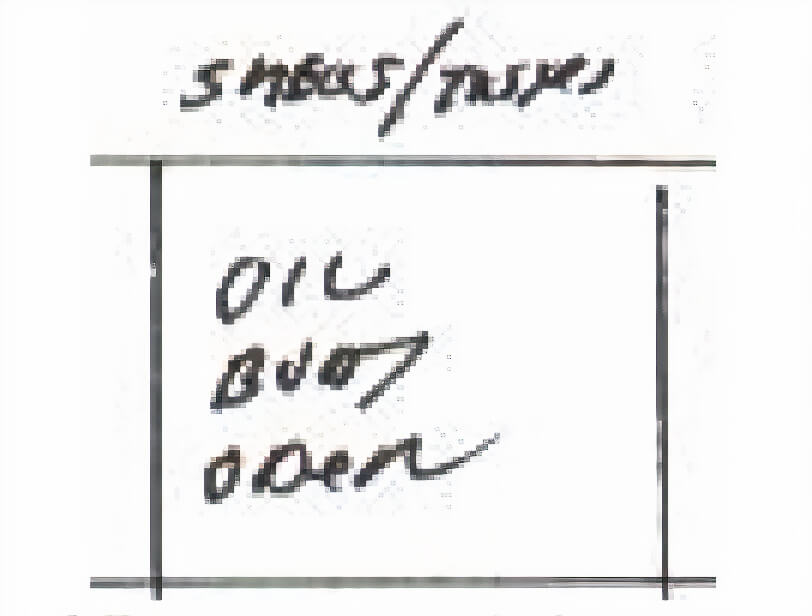



One of the things we bring into our remote viewing session is perception based on the quality and innate character of our being. What and how we think, what we accept as beliefs impact each one of our sessions. In the work above, Derek and Rich was attuned to the chemical aspects of the target, whereas John and Dick noted the body odors. Some of the viewers will consistently demonstrate strengths and weaknesses in sensory perception.
In Captain Williams article (Note 2), mention is made of deep cuts in the wooden railing and on top of the hatch where the yawl was stored. This indicated that the crew had probably used an axe to cut the yawl loose, rather than untie it.



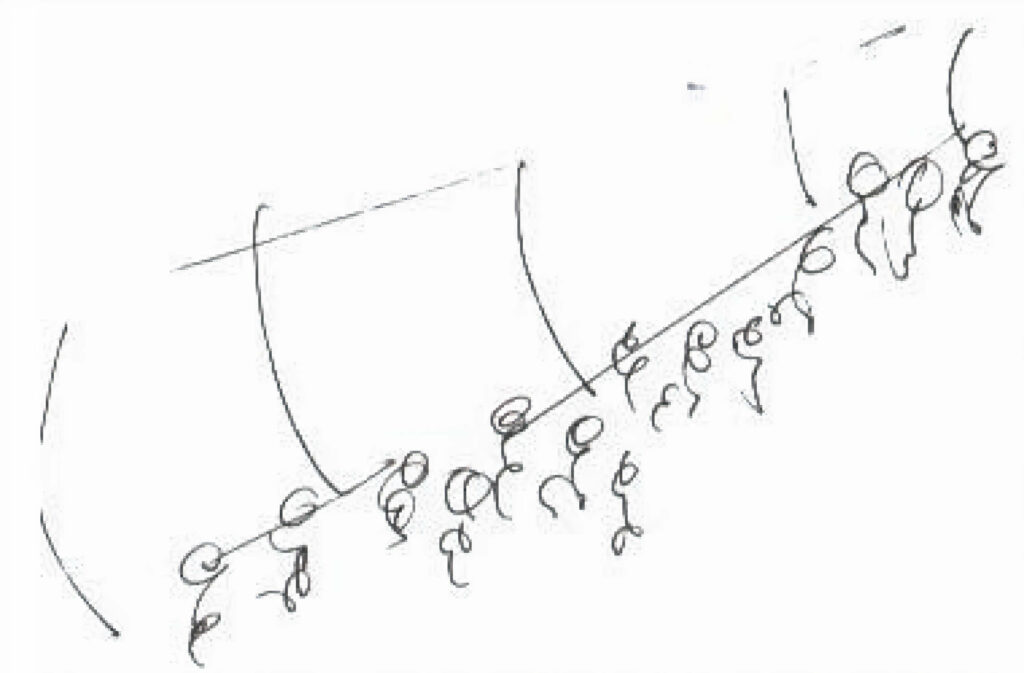





Dick’s depiction of human elements in this target reflects some contamination (human on cycles in a couple areas); however, like Debra’s connecting humans above, Dick’s sketch represents the low level gestalt present in the target-humans moving somewhere.
In addition to a group of humans moving in a specific direction, Dick perceived humans working to cover something.
Several viewers perceived severe weather conditions in their sessions. Captain Williams’ article (note 2) on the Seaquake theory indicates possible gale storm conditions during the journey of the Mary Celeste.

In the map above, Captain Williams identifies the path of the Mary Celeste. He theorizes that Captain Briggs may have taken the northern trek near Santa Maria island to get to the lee shore, perhaps to take a break from the stormy sea. He speculated that perhaps Captain Briggs’ daughter Sophia was ill and the path toward the leeward side of the island may have given her a slight reprieve from the bad weather.



Both of these images are Richard’s work. He identified water as one of the major environmental gestalts of the target. He maintained this focus throughout his work.

Richard’s work in S4 Cascade hints of the stormy ocean and possible big wave action. This is further corroborated by Dick in his S3 site sketch.
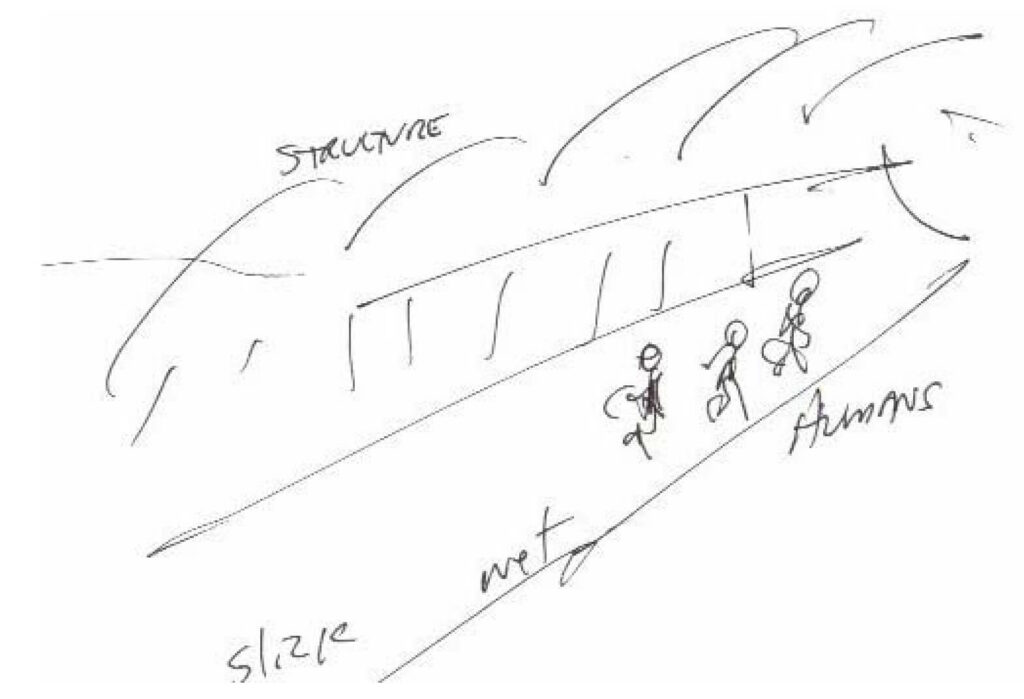
When working analysis, it is important for the analyst to discern the product visually perceived and graphically illustrated by the viewer. We take the entire work of the viewers and break it down into its correlative gestalts. Some patterns visually stand out when comparing the data to the feedback. In the above sketch, I believe that Dick had sketched a massive wave which may have crashed over the vessel.
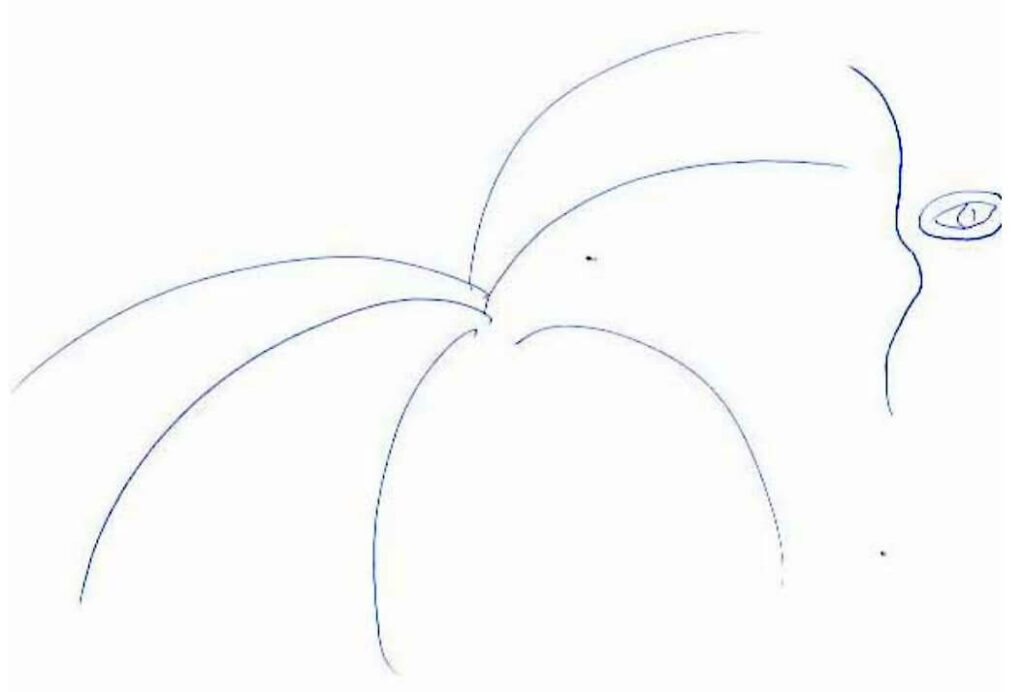

A significant element in analysis is the working notes. In reviewing the collective data of this target, I have identified the following information that have identified by two or more viewers:
Target has circular, angular and vertical aspects.
Triangles and oval shapes are aspects of this target
Target also contains elements that are wet, simplex, dynamic, and natural
Energy, coiled lines and peaks are also affiliated with this target
Running water, waves, splashing, sloshing, swirling water, and whirling wind are part of this target
Talking is heard
There may be chemical, burning, and sweaty smells associated with this target
Aspects of this target are smooth, hard, some metallic textures
Multiple humans are involved with this target
Aspects of this target may be a floating structure containing enclosures with stale air
Humans may be bombarded by water or moving energy at or near this target
Aspects of this target may contain a circular room on a floating structure that may be filled with water
There is a strong current of energy affiliated with this target
Possible foliage, animals and vegetation near this target (Did the crew actually make it to shore?)
Themes
Part of our work as analysts is to identify the significant theme prevalent in the work of each viewer. Based on the data submitted by the viewers, this is what I felt constituted the major theme of their work.
VIEWER | THEME |
Allen | Floating object containing stale air |
John | Rising, cascading energy |
Terri | Natural energy, human(s) dying, Christian symbology |
Dick | Movement of multiple humans |
Derek | Peaks, copious water activity with human involvement |
Richard | Heavy/high wave action interacting with solid structure |
Monitored S5 Sessions
The target ID was F5T9-P5H2 and the cue was BENJAMIN SPOONER BRIGGS/DISAPPEARANCE EVENT/NEAR PAST.
Terri worked the target using the HRVG methodology. In monitored remote viewing, the actual calling point for further remote viewing involvement is at S3. If the monitor determines that the viewer’s S3 portrays sufficient information for the viewer to move on, then the viewer will be allowed to continue through S5 Edging and Priming. If the monitor does not feel that the viewer is on target, then he/she will inform the viewer to move to the lounge area or end the session.
In double blind remote viewing where the monitor and viewer have no knowledge of the target, the monitor will have to conduct an assessment of the data stream and make a call based on the data provided up through S3.
In this session, Terri’s S3 reflected enough data for her to continue working through S5. Terri had absolutely no problem identifying the base target, the human element (Benjamin Spooner Briggs).


I included this sketch Terri drew in S1 (Visual Ideogram3) because her work reflects something Rene Warcollier noticed when he conducted experiments in telepathy.4 He called it “dissociation.” Dissociation is the “irrational and mechanistic decomposition of the target into elements.” (pg 10). It is a very common element prevalent in remote viewing. Terri’s work above is an example of how her mind received the data from the subconscious as bits and pieces.
She recreated the image on paper in an unrecognizable format. Sometimes data is lost between the transmission and reception process in remote viewing, or perhaps it would be more appropriate to say that the data is taken apart like bits and pieces of a puzzle and the lines, shapes and forms are rearranged into an unrecognizable creation.

Throughout her work in this session, Terri continued to focus on a human’s neck. She made several sketches and seemed to be drawn to the image’s neck.
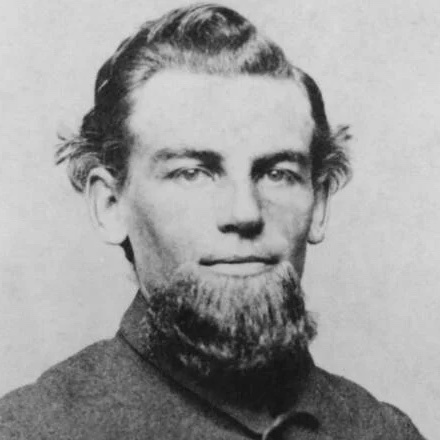



Terri drew these figures in her work. She had a clear indication of a human figure involved. Her work revealed feminine aspects on the human element (women’s voices, women talking, reading, singing).
After Terri completed S5 Edging, two advanced protocols used in the HRVG modicum, she moved to a comfortable position and began a cyclic tapping of her finger (this action is part of the protocol for this module). My goal was to observe her and wait for her to miss three cycles of the tapping. This would indicate that she was in high theta and “ready” for questioning.
All monitored sessions in HRVG begin by the monitor reciting the target identification in a clear voice. Next, I began by asking her to declare all visuals that may become encumbrances throughout the session.
On August 16, 2003, I conducted a monitored Stage 5 (Extended Remote Viewing-ERV) session with Terri as the viewer. During the session, Terri noted several women standing and whispering near an oval object, perhaps a table. She also referred to an object with stiff fabric.
In a movement order execution, she found herself above the vessel looking at a “pair of eyes, with or like glasses, star-like or in the shape of a star.” She made reference to something glowing and speeding. She returned to a circle of women in long dresses.
A week after Terri’s session, Jason monitored Anne. I gave the target a different cue in order to obtain a different perspective. Anne’s target identification was D3H2-Z5W8 and the cue was “Crew of the Mary Celeste/Disappearance Event/Near Past.” The intent was to find the reason for the disappearance of the crew from the ship.
Anne’s work identified peaked structures with land and vegetation. She heard voices and bells and had the sense of something wooden. One common aspect related to several other viewers’ work was her description of a rocky landscape and a whirlwind in visuals and sounds.


During her monitored session, Anne saw small structures with people near them. She identified a wooden panel, rectangular, with door and windows, and another wooden structure, taller, “church-like.” She informed the monitor that “people worked here.”
In describing water, she saw a small boat in the water with ripples and waves. She continued to describe a shoreline with people talking and noted a fishy smell.


This is Anne’s water graphic and her work in S4 Cascade. The water gestalt is wavy and rippling and again, she mentions wind, breeze and boats with waves.
Popular Beliefs Through The Years
In my research for collateral data, I came across several hypotheses on what may have happened to the crew of the Mary Celeste. The most popular are:
Mutiny – Possibly an obvious explanation; however in light of the credentials and character of the crew, this may be ruled out. The Captain was a Christian man of principle and the crew was apparently trustworthy. During that time, the official explanation put out by both the British and American authorities was that the crew may have gotten the alcohol, murdered the captain and his family, and then somehow escaped to another vessel. But there were no visible signs of a struggle on board, and if the crew had escaped, some of them would probably have turned up later. The yawl boat was a small four-oared boat carried over the main hatch was missing, suggesting that at least some of the missing people could have left the vessel in it.
Piracy – Not likely. The contents of the vessel and personal effects of the passengers were intact on the vessel. If piracy was a plausible element, I believe these items and possibly the ship’s food supply and cargo would have been pilfered.
Conspiracy – The Captain owned one third of the ship, so there would not be much to gain from sabotaging his own vessel.
Explosion – Possibly. The data above indicated that the cargo was volatile. When one of the barrels burst, and hatch covers were off, possibly by force, the probability factor may have weighed significantly with the captain. On any vessel, the fear of fire is always a concern and this could have been the situation in which the captain had to make a judgment call. However, the viewers who worked this target did not consistently identify a major explosion.
Madness – Another possibility. The captain was depicted as a rational, pious man of scrupulous character. However, he could have retracted from his sanity and caused the crew to abandon the vessel. None of our viewers corroborated this, however.
Poisoning – One report indicated that a form of fungus could have developed on the staples and caused suicidal tendencies, however, this doesn’t seem plausible as the food and water on board the vessel were both in good condition.
Storm or tidal wave – Some people claim this is unlikely. Why would a ship’s captain abandon a vessel and put his passengers and crew on a smaller vessel to be tossed around the high waves? Despite the skepticism, some of our viewers indicate whirling wind and high waves in their work.
UFO contact – Some people claim that a UFO came down and whisked the crew away. Our viewers did not corroborate this in their work.
As indicated, many theories have evolved, ranging from attacking monsters from the deep and aliens kidnapping to nature’s wrath, piracy and mutiny. But no one has yet ever found any evidence or proof to confirm any of them.
Another piece of evidence to what really happened may be the Fosdyk papers.5
According to an article written by schoolmaster Howard Linford published in 1913 (41 years after the Mary Celeste was found) in the Strand magazine of London, a well-educated and much-traveled employee of his named Abel Fosdyk, had left some papers and notes after his death explaining not only the fate of the crew but also the curious cut marks that were found in the bows of the Mary Celeste.
Fosdyk claimed that he had been a secret passenger on the ship’s last voyage and the only survivor of the tragedy that overtook it. Being a close friend of the captain, Fosdyk convinced Briggs to give him secret passage because, for some undisclosed reason, he had to leave America in a hurry. During the voyage Briggs had the ship’s carpenter build a special deck in the bow for his small daughter. It was the supporting struts for this deck that were slotted into the cuts in the bow planks.
One day, after a lengthy argument with the mate about how well a man could swim with his clothes on, Briggs leaped into the water and started swimming around the ship, as to prove his point. Couple of men followed while the rest of the crew watched from the deck.
Suddenly, one of the sailors swimming around the bow gave a yell of agony. Everyone, including the captain’s wife and child, crowded onto the newly built deck which promptly collapsed under their combined weight. They all fell into the sea, where all were devoured by the sharks that had attacked the first seaman.
As the only survivor of the shark attacks because of his luck of falling on top of the shattered decking, Fosdyk clung to it as the Mary Celeste drifted away. He floated for days until he was washed up half dead on the northwest coast of Africa.
Other details were somewhat doubtful based on the account of Fosdyk. He claimed that the Mary Celeste weighed 600 tons, when it actually weighed 282 tons. Fosdyk also says that the crewmen were English, when, in fact, they were mostly Dutch. And most of all, it seems highly improbable that anyone would go swimming around a ship that, according to the Dei Gratia evidence, must have been making several knots at the time. Bizarre as it is, no better explanation than Fosdyk’s has so far emerged.
Scenario And Conclusion
There is a repetitive pattern overshadowing the entire work that leans heavily toward the possibility of a massive watery whirlwind encountered by the Mary Celeste. It is possible that the captain may have assumed the severity of the strong winds encountered by the vessel would tear it apart. The cyclonic winds may have been powerful enough to cause the captain and crew grave concern for their safety, and their fear was strong enough for the entire crew to make a hasty abandonment of the ship. Perhaps some of the crew made it safely ashore;
however, the data collected in this presentation does not lend itself to the assumption that they survived for a long period of time. Obviously, the crew was unable to return to the vessel, and if, indeed, high winds were a factor, the possibility exists that they may have been irreversibly blown off course and away from the ship. Despite the data collected, I assume that if the ship was deliberately abandoned, it would have been a temporary measure.
Epilogue
I would like to invite other schools or disciplines of remote viewing to send me their data if they have or intend to work this target, and I will update this information accordingly.
None of the viewers who worked this target had any prior knowledge of this event. When I cued this target for viewing, I had no preconceived ideas of the event. I deliberately remained ignorant of the target information until it was time to conduct analysis. Until I conducted analysis and began the collateral research, I did not know about the historical significance of the Mary Celeste and its vanished crew. Furthermore, I deliberately conducted the analysis on the viewers’ sessions prior to embarking on my quest for collateral data to substantiate the recorded data. While the data provided by the viewers who worked this target suggest a whirlwind-type storm, I cannot help but wonder if the data they obtained was actually data provided them by their subconscious in terms of their bi-location to that event, or, if their data reflects a general consensus that may be hanging in the matrix. The only way to answer this would be for other viewers to work related sessions. I wonder if the information they obtained may be a dangling event left by other people who reported their theories. If that is the case, then perhaps the signature remaining in the collective matrix was strong enough for the viewers to grasp and illustrate. The percipients may then mirror what was hanging in the collective matrix like ripened fruit on the information vine of foreknowledge. I am certain that in time, remote viewers can provide the information once they can get passed the embedded gateways of theories dangling in the substrata. However, until someone finds the bodies of the crew, if any remain or other substantive information, the data would remain speculative at best.
If anyone has obtained data contrary to what the viewers who worked this target have identified, or any new data nor previously identified by the myriad of writers and researchers, please let me know and I will include it in an update to this report.